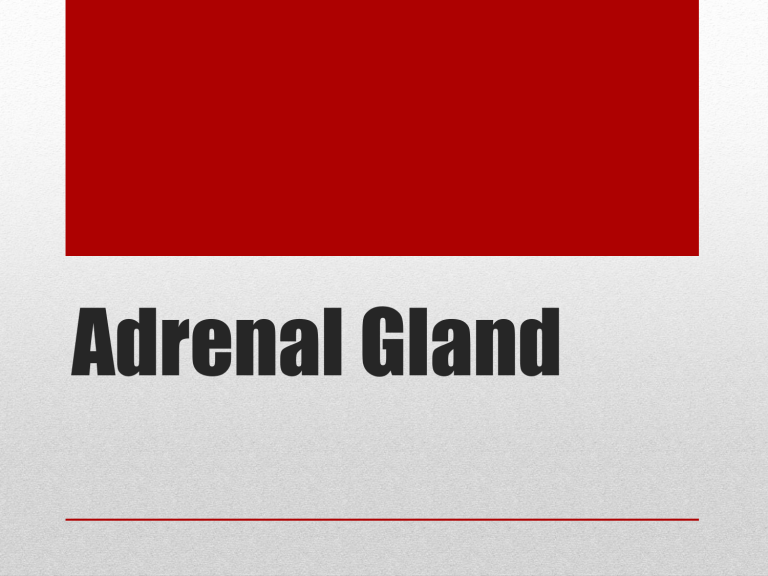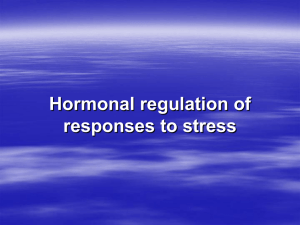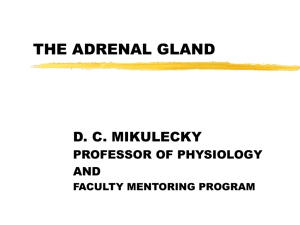
Adrenal Gland • Paired endocrine gland consist of two distinct parts with different functions and embryonic origins. • Adrenal cortex – originates from mesodermal tissue located between the dorsal messentery of the gut and the medial surface of the messenteric kidney. • It synthesizes steroid hormones called corticosteroids. • Adrenal medulla – originates from the neuroectodermal cells from the primitive ganglia of the celiac plexus. • Contains chromaffin cells – synthesize and release catecholamines, epinephrine, and norepinephrine in response to symphathetic stimulation. Functional Anatomy • Adrenal glands literally “the glands next to the kidneys” located retroperitanially in close opposition to the kidneys. • All domestic animals highly irrigated adrenal glands (receiving blood from several arterial sources). • Main nerve supply is sympathetic nerve that synapse with medullary cells. • Also receive few parasympathetic fibers but little is known about their functions. Functional Anatomy • Humans and other mammals – cortex surrounds the medulla • Sharks – completely separated • Amphibians – separate but in close contact • Avian – intermixed medullary and cortical tissue and is unpaired Functional Anatomy • Constitute approximately 80%-90% of the mass of the adrenal glands. • Corticocytes – parenchymal cells of the cortex, has a unique characteristics, and source of the various steroid hormones • Cytoplasm contains large number of lipid filled droplets (most lipids are cholesterol) • Abundant smooth ER • Paucity of RER • Large Golgi complexes and numerous mitochondria • Inability to store hormones Adrenal Cortex • Three distinct zones. 1. Zona glomerulosa – thinnest and outermost zone • Rumiants and humans – consist of clusters of small and darkly stained corticocytes arranged in whorls • Other animals – zona arcuata, corticocytes are grouped in the form of arcs. • Dogs and cats – corticocytes are larger and lighter. • Depending on the species, corticocytes appears to be flattened or are polyhedral in outline. • Mineralocorticoids (Aldosterone) Adrenal Cortex Zona glomerulosa consists of rounded clusters of columnar cells principally secreting the mineralcorticoid aldosterone • Three distinct zones. 2. Zona Fasciculata • Middle zone and thickest of the three zones. • Made up of cuboidal to polyhedral cell form cords that are one cell wide and are perpendicular to the capsule of the gland. • Corticocytes are large with large, vesicular nuclie and have an abundance of lipid and lipid droplets. • Cytoplasm appears foamy and lightly stained compared to the two adjoining zones. • Glucocorticoids (cortisone and cortisol), and androgens Adrenal Cortex Zona fasciculata, consists of long cords of large, spongy-looking cells mainly secreting glucocorticoids such as cortisol • Three distinct zones. 3. Zona Reticularis • Innermost zone of the adrenal cortex • Contains small corticocytes arranged in a network of anastomosing cords • Glucocorticoids and androgens Adrenal Cortex Small, better stained, arranged in a close network and secrete mainly sex steroids • Composed of large, pale-staining polyhedral cells arranged in cords or clumps and supported by a reticular fiber network. • Medullary parenchymal cells, known as chromaffin cells • Chromaffin cells of the adrenal medulla of humans and are part of the endocrine system and an important part of the symphathetic nervous system. • Chromaffin cells contain enzymes for the synthesis of norepinephrine. • Other medullary cells contain the necessary enzymes and co-factor to form epinephrine. Adrenal Medulla • Medullary chromaffin cells contain many electrondense granules, 150–350 nm in diameter, for hormone storage and secretion. • These granules contain one or the other of the catecholamines, epinephrine or norepinephrine. • Ultrastructurally the granules of epinephrinesecreting cells are less electron-dense and generally smaller than those of norepinephrine-secreting cells. • Norepinephrine-secreting cells are also found in paraganglia (collections of catecholamine-secreting cells adjacent to the autonomic ganglia) and in various viscera. Adrenal Medulla • Medullary chromaffin cells are innervated by cholinergic endings of preganglionic sympathetic neurons, from which impulses trigger hormone release by exocytosis. • Epinephrine and norepinephrine are released to the blood in large quantities during intense emotional reactions, such as fright, and produce vasoconstriction, increased blood pressure, changes in heart rate, and metabolic effects such as elevated blood glucose. Adrenal Medulla • These effects facilitate various defensive reactions to the stressor (the fight-or-flight response). • During normal activity, the adrenal medulla continuously secretes small quantities of the hormones. • The conversion of norepinephrine to epinephrine (adrenalin) occurs only in chromaffin cells of the adrenal medulla. • About 80% of the catecholamine secreted from the adrenal is epinephrine. Adrenal Medulla The micrograph shows they are large pale-staining cells, arranged in cords interspersed with wide capillaries. Faintly stained cytoplasmic granules can be seen in most chromaffin cells. X200. H&E. EM reveals that the granules of norepinephrine-secreting cells (NE) are more electron-dense than those of cells secreting epinephrine (E), which is a function of the chromogranins to which the catecholamines are bound in the granules. Most of the hormone produced is epinephrine, which is only made in the adrenal medulla. • Adrenal steroids (four major types) • Glucocorticoids • Cortisol • Corticosterone • Mineralocorticoids • Aldosterone • Androgens • Dehydroepiandrosterone • Androstenedion • Estrogens • Estradiol-17ß Hormones of the Adrenal Cortex BIOSYNTHESIS OF STEROID HORMONES • Begins with cholesterol, (parent compound). • Corticosteroids are formed primarily from absorbed cholesterol. • Remainder is formed from acetate from the corticocytes. • Cholesterol it is transported to the adrenal cortical cells by low density lipoproteins • After LDL bind to the membrane of steroidonic cells, the LDL-receptor complexes are internalized by receptor-mediated endocytosis. • In the cell LDL receptor dissociates and the receptor is re-incorporated to the cell membrane Biosynthesis • LDL is catabolized and cholesterol is liberated (this intracellular cholesterol maybe used directly for steroidogenesis or sterified and stored in lipid droplets.) • Enzymes for steroidogenesis are located in the mitochondria and endoplasmic reticulum. • The final steroid pruduct diffuse from the corticytes into the circulations. • Steroids are not stored in the cells of the adrenal cortex. Biosynthesis • Steroids are secreted by the adrenal glands enter the blood stream as non-polar molecules that are insoluble in water. • 60%-95%, of adrenal steroids released into the circulation are recessively bound to blood proteins. • Transcotin – glucocorticoids and mineralocorticoids • Albumin – progestagens • Sex hormone binding globulin – androgens and estrogens Transport • Only free or unbound steroids passively diffuse through the lipid bilayer of the cell membrane of the target cells to illicit biological effect. • Half life of cortisol is less than 2 hours, considerably longer than that of the chatechyolamines release from chromaffin cells of the adrenal medulla. Metabolism • Vast majority of steroids are degraded in the liver while the remainder is degraded in the kidneys, • Process of degradation of corticosteroids undergo various reductions, oxidations and hydroxylation before conjugation with glucoronic acid or sulphates. • The conjugated metabolites are water water soluble which facilitates excretion. • 75% excretes in the urine and 25% into the SI as a component of bile. Elimination • Steroids hormones exert their effects by binding to and activating hormone-specific receptors in target cells. • Glucocorticoids and mineralocorticoids enter cells by diffusion and bind to hormone-specific receptors in the cytoplasm of the target cells to induce a conformational change in the receptor. • In the nucleus, dimers are activated hormonereceptor complex with a high affinity to specific DNA binding sites to direct gene transcription. Mechanism of Action • After transcription and synthesis of biologically active mRNA hormoneinduced proteins elicit the steroid-specific actions or functions in the target cells. • Once the hormone-receptor complex has interacted with the gene, the receptor is recycled as inactive receptor and the steroid hormone passively diffuses from the cell Mechanism of Action GLUCOCORTICOIDS • Cortisol (very potent, accounts for about 95 per cent of all glucocorticoid activity) • Corticosterone (provides about 4 per cent of total glucocorticoid activity, but much less potent than cortisol) • Cortisone (synthetic, almost as potent as cortisol) • Prednisone (synthetic, four times as potent as cortisol) • Methylprednisone (synthetic, five times as potent as cortisol) • Dexamethasone (synthetic, 30 times as potent as cortisol) Glucocorticoids • Cortisol and corticosterone – principal glucocorticoids • Cortisol predominates in humans, horses, pigs, sheep, dogs and cats. • Corticosterone predominates in rabbit, mouse and rat. • New born calf – cortisol is the major secretory product and corticosterone does not appear until 10 days after birth. • Adult cattle – secretes significant amounts of both glucocorticoids. Glucocorticoids • Approximate ratio of cortisol and corticosterone in adrenal venous blood of some mammals. • • • • • Bovine – 0.05:1 to 1:1 Sheep – 15:1 to 20:1 Dogs – 2:1 to 5:1 Humans and cats – 5:1 to 10:1 Rats and rabbits – 0.05:1 Glucocorticoids • Dogs and cat do not have circadian rhythm in the secretion. • Diurnal animals (pigs, sheep, and horses) have several higher of secretion during the early day hours than in last hours of day hours. • Nocturnal animals (mice and rats) higher level of secretions during early hours of darkness than during the waning hours of darkness Glucocorticoids (Daily Rhythms) • Stimulation of Gluconeogenesis • Cortisol increases the enzymes required to convert amino acids into glucose in the liver cells. • Results from the effect of the glucocorticoids to activate DNA transcription in the liver cell nuclei • Cortisol causes mobilization of amino acids from the extrahepatic tissues mainly from muscle. • result, more amino acids become available in the plasma to enter into the gluconeogenesis process of the liver and thereby to promote the formation of glucose. Effects of Cortisol on Carbohydrate Metabolism • Decreased Glucose Utilization by Cells • Causes a moderate decrease in the rate of glucose utilization by most cells in the body • Elevated Blood Glucose Concentration and “Adrenal Diabetes.” • Increase gluconeogenesis and reduction in the rate of glucose utilization cause the blood glucose to rise and timulates secretion of insulin • Increased plasma levels of insulin, however, are not as effective in maintaining plasma glucose as they are under normal conditions Effects of Cortisol on Carbohydrate Metabolism • Reduction in Cellular Protein • Caused by both decreased protein synthesis and increased catabolism of protein already in the cells. • Effects may result from decreased amino acid transport into extrahepatic tissues • Cortisol Increases Liver and Plasma Proteins • results from a possible effect of cortisol to enhance amino acid transport into liver cells (but not into most other cells) and to enhance the liver enzymes required for protein synthesis. Effects of Cortisol on Protein Metabolism • Increased Blood Amino Acids, Diminished Transport of Amino Acids into Extrahepatic Cells, and Enhanced Transport into Hepatic Cells. Effects • Increased rate of deamination of amino acids by the liver • Increased protein synthesis in the liver, • increased formation of plasma proteins by the liver, and • Increased conversion of amino acids to glucose-that is, enhanced gluconeogenesis. Effects of Cortisol on Protein Metabolism • Mobilization of Fatty Acids • Promotes mobilization of fatty acids from adipose tissue that increases the concentration of free fatty acids in the plasma, which also increases their utilization for energy • Have a direct effect to enhance the oxidation of fatty acids in the cells. • Neutral fats make up the largest pool of energy in the body. Effects of Cortisol on Fat Metabolism • Increased mobilization of fats by cortisol, oxidation of fatty acids helps shift the metabolic systems of the cells from utilization of glucose for energy to utilization of fatty acids in times of starvation or other stresses. • Glucocorticoids permissively enhance the actions of glucagon, epinephrine, and growth hormone in mobilization of fatty acids. • It promotes food intake by stimulating the appetite center of the hypothalamus. Effects of Cortisol on Fat Metabolism • Endocrine System • GCC antagonize the effect of insulin in muscles, adipose tissue and the liver. • Enhances the effect of glucagon and epinephrine on intermediary metabolism • Induces hyperglycema and hyperinsulinemia which leads to diabetis mellitus in dogs. Systemic Effects • Musculoskeletal System • Hypersecretion of GCC stunts growth of young animals • Wasting or atrophy of muscle tissue in adult animals (catabolic effect on muscle protein) • Bone mass can also be lost (decrease osteoblast activity and inhibition of collagen synthesis) • Antagonizes action of Vit. D (absorption of calcium in the intestines) Systemic Effects • Skin and Connective Tissue • Modulate the proliferation and differentiation of fribroblasts (maintenance of skin and connective tissue). • Thinning of skin and subcutis • Hypersecretion of GCC leads to hyperpigmentation, pyoderma, seborrhea, and atrophy of hair follicle and loss of hair. Systemic Effects • Cardiovascular System • Maintenance of normal vascular tone and blood pressure. • Enhance vascular response to vasoactive agents (catecholamines, angiotensins and vasopressin) • GCC enhances the activity of Na, K, ATPases in cardiocytes. • Increase force of contraction and increase rate of contraction Systemic Effects • Renal System • GCC impairs the ability of the kidney to excrete a load of water • Lead to decrease rate of GFR and increase in vasopressin. • High GCC causes increase absorption of Na excretion of K. • Increase blood flow to the kidneys (direct vasodilatory effect on renal vessels) Systemic Effects CORTISOL IS IMPORTANT IN RESISTING STRESS AND INFLAMMATION • Stress that increase cortisol release • • • • • • • • Trauma of almost any type Infection Intense heat or cold Injection of norepinephrine and other sympathomimetic drugs Surgery Injection of necrotizing substances beneath the skin Restraining an animal so that it cannot move Almost any debilitating disease • Cortisol has two basic antiinflammatory effects: • it can block the early stages of the inflammation process before inflammation even begins, or • if inflammation has already begun, it causes rapid resolution of the inflammation and increased rapidity of healing. Anti-inflammatory Effects of High Levels of Cortisol • Cortisol stabilizes the lysosomal membranes • Most important anti-inflammatory effects • Proteolytic enzymes which are mainly stored in the lysosomes, are released in greatly decreased quantity. • Cortisol decreases the permeability of the capillaries • Prevents loss of plasma into the tissues • Reduces migration of white blood cells into inflamed area. Cortisol Effects in Preventing Inflammation • Cortisol decreases both migration of white blood cells into the inflamed area and phagocytosis of the damaged cells. • diminishes the formation of prostaglandins and leukotrienes that otherwise would increase vasodilation, capillary permeability, and mobility of white blood cells. Cortisol Effects in Preventing Inflammation • Cortisol suppresses the immune system, causing lymphocyte reproduction to decrease markedly. • T lymphocytes are especially suppressed • Reduced amounts of T cells and antibodies in the inflamed area lessen the tissue reactions that would otherwise promote the inflammation process. • Cortisol attenuates fever mainly because it reduces the release of interleukin-1 from the white blood cells. • principal excitants to the hypothalamic temperature control system. The decreased temperature in turn reduces the degree of vasodilation. Cortisol Effects in Preventing Inflammation • Perhaps, results from the mobilization of amino acids and use of these to repair the damaged tissues • Perhaps it results from the increased glucogenesis that makes extra glucose available in critical metabolic systems • Perhaps it results from increased amounts of fatty acids available for cellular energy • Perhaps it depends on some effect of cortisol for inactivating or removing inflammatory products. Cortisol Causes Resolution of Inflammation • Anti-growth Effect • Inhibit GH secretion (somatic growth), will result to muscle atrophy and muscular weakness • Poor wound healing, decrease fibroblast proliferation and decrease connective tissue strength andquality • Inhibition of Vit. D metobolites (osteoporosis) • Inhibition of calcium absorption in the gut • Increased collagen degradation • Inhibit collagen mitosis (inhibition of Vti. D) Other Effects • Exerts its effects by first interacting with intracellular receptors in target cells. • Cortisol binds with its protein receptor in the cytoplasm • Hormone-receptor complex then interacts with specific regulatory DNA sequences (glucocorticoids response element) to induce or repress transcription. • Increase or decrease transcription of many genes to alter synthesis of mRNA for the proteins that mediate their multiple physiologic effects. Cellular Mechanism of Cortisol Action Regulation of GCC secretion MINERALOCORTICOIDS • Aldosterone (very potent, accounts for about 90 percent of all mineralocorticoid activity) • Desoxycorticosterone (1/30 as potent as aldosterone, but very small quantities secreted) • Corticosterone (slight mineralocorticoid activity) • 9a-Fluorocortisol (synthetic, slightly more potent than aldosterone) Mineralocorticoids • Regulate the concentration of sodium and potassium in the exrtracellular fluid • Increasing renal uptake of sodium • Stimulating the excretion of potassium in the urine. • Stimuli fro secretion • Changes in electrolyte level and water balance Mineralocorticoids • Most potent mineralocorticoids and release from zona glumerulosa • Affinity to blood proteins is relatively low • 50% loosely bound to albumin • 40% unbound • 10% bound to transcortin • Action is not evident untill 15 – 30 minutes after administration. • Major targets are the epithelial cells of the collecting tubules of the kidneys. Aldosterone • Increases the activity of Na+ -K+ ATPases or Na + -K + pumps • Cause reabsorption of of Na+ from the fluid of the renal tubules and excretion of K+ and H + into the urine. • Increases the activity of Na+ -K+ ATPases in the epithelial cells of the sweat glands, stomach, colon, and ducts of the salivary glands. • Reabsorption of Na+ and excretion of K+ and H+ Aldosterone • Altered by circadian rythms (synchronized with sleep-wake cycle) • Diurnal animals – high in the morning than in the evening • Nocturnal animals – higher during in the early hours of darkness than waning hours of darkness • Dogs – not exhibit a daily rhythm in the secretion. • Two important Factors • Renin-angiotensin System • Changes in extracellular concentrations of Na+- K+. Regulation of Mineralocorticoid Secretion • Factors that influences the secretion of renin • Low levels of Na (monitored by cell of the macula densa) • Synthesis and release of glucocorticoids – increase reabsorption of Na and H2O by kidney tubules – lead to increase in blood volume and blood pressure • Blood volume (monitored by cells of the juxtaglumerular apparatus) Regulation of Mineralocorticoid Secretion • Factors that influences the secretion of renin • Blood pressure (monitored by cells of the juxtaglumerular apparatus) • Decrease BP in the afferent arterioles of renal glumeruli – ilicit an increases of secretion of renin • Sympathetic nerve activity Regulation of Mineralocorticoid Secretion • Inhibitory Factors • • • • Increase in sodium levels Increase blood volume Increase blood pressure Angiotensins and vasopressins Regulation of Mineralocorticoid Secretion • Hyperadrenocorticism • Characterized by development of peculiar redistribution of body fat and have a pot bellied appearance. • One of the most common endocrine diseases in dog • Occasionally in cats, rare in horses and other species Dysfunctions of the Adrenal Cortex • Types of Hyperadrenocorticism 1. Primary Hyperadrenocorticism • Accounts for ~15% of all cases of naturally occurring hyperadrenocorticism in dogs • Caused by adenomas or carcinomas of the adrenal cortex • 20% in cats is caused by neaplasms • Parvocellular neurons and pituitary corticotropes are atropied due to inhibitory effects of glucocorticoids. Hyperadrenocorticism • Types of Hyperadrenocorticism 2. Secondary Hyperadrenocorticism • Accounts for 85% of the cases of naturally occurring hyperadrenocorticism in dogs, • 90% is caused by ACTH producing neoplasms of the pars distalis or the pars intermedia. • 10% hyperplasia and hypertrophy ACTH producing cells (pars distalis or the pars intermedia) • Horses – neoplasia of the pars intermedia Hyperadrenocorticism • Types of Hyperadrenocorticism 3. Iatrogenic/Pharmacological Hyperadrenocorticism • Occurs because of widespread use of synthetic longacting glucocorticoids. • Long-acting glucocorticoids can lead to iatrogenic hyperadrenocorticism, followed by hypoadrenocorticism. • Parvocellular neurons and pituitary corticotropes are atropied in animals affected by the prolonged treatment with natural or synthetic glucorcorticoids Hyperadrenocorticism 2 types • Primary Hyporadrenocorticism • Most common form and naturally occurring accounting to nearly all cases of the disease • Characterized by deficiency in the secretion of both glucocorticoids and mineralocorticoids. • Associated with atrophy or destruction of the zona fasciculata and zona reticularis and less frequently, atrophy or degeneration of the 3 zones Hyporadrenocorticism 2 types • Secondary Hyporadrenocorticism • Naturally occurring are rare in domestic species • Associated with hyposecretion of ACTH from the pituitary. • Atrophy of the zona fasciculata and zona reticularis which results to glucocorticoid deficiency. Hyporadrenocorticism CATECHOLAMINES • Secreted in the adrenal medulla and referred to as the emergency hormone. • Released by activation of fight or flight mechanism. • (cold, apnea, and hypoglycemia) • Constitutes the principal regulatory mechanism to elicit the sympathetic responses that allow animal to meet physical demands and responds to life threatening challenges. Catecholamines • Synthesize from tyrosine by chromaffin cells by adrenergic and dopaminergic neurons • Tyrosine is absorbed directly from the blood into the cytosol of the chromaffin cells and hydrolyze to 3,4-dihydroxypenylalanine (DOPA). • DOPA is the decarboxylated into the cytosol to form dopamine. • After transport to the granules of chromaffin cells by an active process. Biosynthesis of Cathecolamines • Dopamine is converted into norepinephrine by ßhydroxylase. • In chromaffin cells devoid of phenylethanolamine Nmethyltransferase noirepinephrine is stored in granules until it is secreted from the cell. • Mammals also contain cells that have phenylethanolamine N-methyltransferase noirepinephrine in the cytosol. • Norepinephrine is released into the cytosol where cofactor S-adenosylmethionine serves as a methy donor for the synthesis of the epinephrine that is then stored in secretory granules for release into the circulation • Catecholamines are stored in secretory granules in adrenomedullary cells and dopaminergic and adrenergic neurons throughout the body. • Mammals –adrenal medulla is the primary source of epinephrine • Chromaffin cells and adrenergic neurons – norepinephrine synthesizing cells Storage of Cathecolamines • Calcium and energy in the form of ATP are required for the release of catecholamines. • Release of acetylcholine from preganglionic nerve will stimulate chromaffin cell and postganglionic sympathetic nerve endings causing depolarization of plasma membrane and a concumitant influx of Ca2+ into the cell. • In the adrenal medulla, membranes of the catecholamine-containing granules fuse with the plasma membrane of the chromaffin cell and the contents of the granules are expelled by exocytosis Release and Fate of Catecholamines • Norepinephrine and epinephrine release in adult animals is not constant. • Anxiety and hypoxia – more norepinephrine than epinephrine • Hypoglycemia and activation of flight and fight mechanism - more epinephrine than norepinephrine Release and Fate of Catecholamines • Degradation occurs largely in the kidneys and liver • (combined actions of catechol-ortho-methyl transferase in the cytosol and the mitochondrial enzyme monoamine oxidase). • Catabolism of catecholamines • Ortho-methylation followed by deamination of intermediate metabolites • Deamination followed by ortho-methylationof intermediate metabolites • Most conjugated metabolites are excreted in the urine and bile Release and Fate of Catecholamines • Adrenergic Receptors α Receptors • Both NE and E bind to this • Mostly excitatory except inhibition of GIT motility • α1 subtypes • found in postsynaptic receptors • Contraction effect on vascular and other smooth muscles • α2 subtypes • affect pre-synaptic terminal • Inhibit release of CAT’s Catecholamine Receptors • Adrenergic Receptors ß Receptors • Mostly inhibitory except excitation of myocardium • ß1 subtypes • Mediates direct cardiac effects • ß2 subtypes • Mainly smooth muscle relaxation (vascular, bronchial, uterine); mediates metabolic effects Catecholamine Receptors • Dopaminergic Receptors D1 Receptors • Mediate dilatation of the vascular bed of the heart kidneys, mesentery and cerebrum. • Mediate the release of parathyroid hormones in cattle and possible in other domestic animals. D2 Receptors • Inhibit secretion of aldosterone, prolactin, and renin • May causes emesis or vomiting in humans and animals • Inhibit release of norepinephrine into the synaptic cleft. Catecholamine Receptors • Hormone binding properties of receptors • Changes which affect the target cells or tissues due to the effect of hormone itself (homologous regulation) • Changes in the receptor mediated responses of target cells due to other hormones (heterologous regulation) • Receptor concentration • Down regulation (decreased concentration) • Up regulation (increased concentration) • Receptor signalling • Post-receptor alterations Regulation of Catecholamine • Activation of α1 receptors increase the release of Ca2+ from intracellular storage site • Activation of α2 increases the influx of Ca2+ from extracellular fluid • Inhibition of adenyl cyclase in some cells such as ß cells of the pancreas, adipocytes and adrenergic nerve endings • Activation of ß1 and ß2 increase in adenyl cyclase activity • Activation of D1 receptors activates adenly cyclase andc incerease cAMP levels • Activation of D2 receptors causes inhibition of adenly cyclase Mechanism of Action Central Nervous System Epinephrine Norepinephrine • Anxiety, fatigue and restlessness • Favor the release of ACTH, TSH, and gonadotropins • Increase output of ACTH and TSH in an emergency situation. • No effect Effects of Catecholamines Cardiovascular System Epinephrine Norepinephrine • Increase BP (systolic pressure) • Tachycardia • Coronary dilatation • Vasoconstriction of skin and mucous membranes • Clow down the absorption of anesthetics (subcutneous vasoconstriction) • Increase BP (systolic and diastolic) • Bradychardia • Coronary dilatation • Vasoconstriction of skin and mucous membranes • Hypertensive agent • Prevent hypotension in prolonged surgery Effects of Catecholamines Respiratory System Epinephrine Norepinephrine • Brief period of apnea due to elevated BP acting on carotid artery and direct inhibitory effect on the respiratory center • Increased respiratory depth and rate (CNS stimulation) • Same effect Effects of Catecholamines Muscular System Epinephrine Norepinephrine • Constriction of smooth muscle • Relaxes the body of the urinary bladder • Constriction of the neck of the bladder • Direct inhibition (ß1) and indirect inhibition (α1) of contraction of the GIT smooth muscle • Constriction of smooth muscle • Constriction of the neck of the bladder • Direct inhibition (ß1) and indirect inhibition (α1) contraction of the GIT smooth muscle Effects of Catecholamines Metabolism Epinephrine Norepinephrine • Glycogenolysis in the liver and muscle of dogs and other animals • Increase the release of insulin and glucagon (ß2) • Decrease insulin release (α1) • Same effect Effects of Catecholamines • Hyperfunction of the adrenal medulla • Red brown tumors arise from the chromaffin cells • Catecholamines are being produced constantly or episodically • May also produce various peptides hormones including ACTH, calsitonin and somatostatin • Rare and observed in dogs, cats and horses Pheochromocytomas End… • 1. What do you call the parenchymal cell of the adrenal cortex? • Give the 3 layers of the adenal cortex, 2-4; and hormones they secretes, 5-7. • 8. What do you call parenchymal cell of the medullary? • 9-10. Hormones secreted by the adrenal medulla. • 11-13. 3 types of carrier (blood) proteins Q#4… • 14-15. 2 glucocorticoid hormones • 16. The most potent mineralocorticoids • 17. What is the primary source of epinephrine in mammals? • 18-19. Diseases that results from dysfunction of the adrenal cortex. • 20. What is the rare tumors that may arise from the adrenal medulla that causes catecholamines to be produced constantly or episodically. Q#4…





